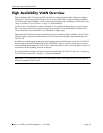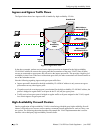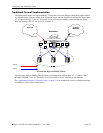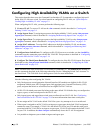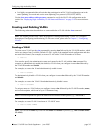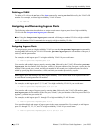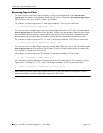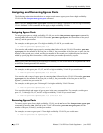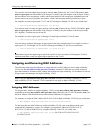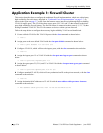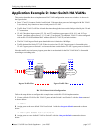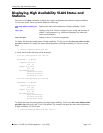
Configuring High Availability VLANs
page 3-14 Release 5.1.6.R02 User Guide Supplement June 2005
Removing MAC Addresses
To remove a MAC address associated with a high availability VLAN, use the no form of the mac-
address-table port-mac vlan mac command. For example, the following command removes MAC
address 00:25:9a:5c:2f:10 from VLAN 20:
-> mac-address-table port-mac vlan 20 no mac 00:25:9a:5c:2f:10
To remove more than one MAC address from a high availability VLAN using a single command, enter
each address on the same command line separated by a space. For example, to remove MAC addresses
00:25:9a:5c:2f:11, 00:25:9a:5c:12, and 01:00:00:3f:4c:10, from high availability VLAN 30, you would
enter:
-> mac-address-table port-mac vlan 30 no mac 00:25:9a:5c:2f:11 00:25:9a:5c:12
01:00:00:3f:4c:10.
Note. Removing the last MAC address from an HA VLAN is not allowed. Deleting the VLAN is required
when there is only one MAC address left.
Configuring Inter-switch Ports for HA VLANs
One scenario using HA VLANs involves configuring ingress ports on one switch and egress ports on a
second switch. In this case, the ports that connect the two switches require an 802.1Q tag for the HA
VLAN.
The vlan 802.1q command is used to tag a port with an HA VLAN. Once this is done, the tagged ports are
identified as inter-switch ports and will carry HA VLAN traffic between the two switches. See “Applica-
tion Example 2: Inter-Switch HA VLANs” on page 3-17 for an example of using inter-switch ports.
Note the following regarding inter-switch ports:
• Fixed ports, 802.1Q tagged ports, and link aggregates on a second-generation module are eligible to
become inter-switch ports for HA VLANs.
• Once a link aggregate is tagged with an HA VLAN, it is not possible to add any more member ports to
the aggregate.
• The HA VLAN and the default VLAN for an inter-switch port should participate in the same Spanning
Tree instance, especially when there are redundant inter-switch connections. If this is not possible—
such as when the 1x1 mode is active and there is one instance per VLAN—then ensure that the Span-
ning Tree state of the inter-switch port remains the same for both VLANs.
For more information about 802.1Q tagging, see Chapter 10, “Configuring 802.1Q.” For more informa-
tion about Spanning Tree modes and instances, see Chapter 6, “Configuring Spanning Tree Parameters,”
and Chapter 3, “Using 802.1s Multiple Spanning Tree.”



